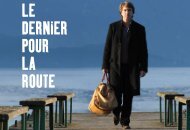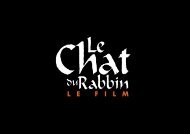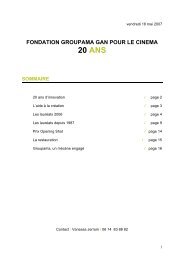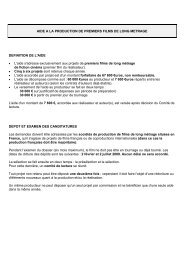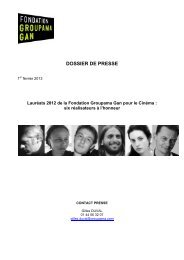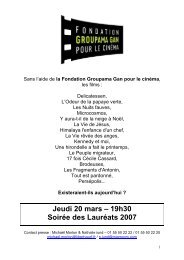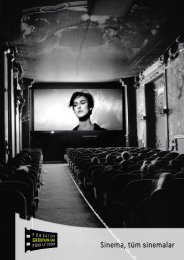Dossier de Presse - Fondation Groupama Gan pour le Cinéma
Dossier de Presse - Fondation Groupama Gan pour le Cinéma
Dossier de Presse - Fondation Groupama Gan pour le Cinéma
- No tags were found...
Create successful ePaper yourself
Turn your PDF publications into a flip-book with our unique Google optimized e-Paper software.
EXE NOUVELLE VAGUE:EXE LES VACANCES 23/04/09 14:46 Page 7La joie <strong>de</strong> restaurer Les Vacances <strong>de</strong> Monsieur HulotThe joy of restoring Mr Hulot’s HolidaySéverine Wemaere - Déléguée généra<strong>le</strong> <strong>de</strong> la <strong>Fondation</strong> Thomson Head of Thomson FoundationGil<strong>le</strong>s Duval - Délégué général <strong>de</strong> la <strong>Fondation</strong> <strong>Groupama</strong> <strong>Gan</strong> Head of <strong>Groupama</strong> <strong>Gan</strong> Foundationrestaurer un film est un acte singulier, qui consiste à redonner vie à une œuvre majeure ou mineure, connueou oubliée, sans <strong>pour</strong> autant trahir la volonté <strong>de</strong> l’auteur, bien souvent déjà disparu. L’exercice est diffici<strong>le</strong> etpassionnant, et il est avant tout une <strong>le</strong>çon d’humilité. Il impose <strong>de</strong> s’immiscer avec délicatesse dans la vie et<strong>le</strong> travail <strong>de</strong> l’auteur, <strong>pour</strong> tenter <strong>de</strong> saisir ses intentions et ses doutes, ses difficultés et ses satisfactions. Feuil<strong>le</strong>terses carnets <strong>de</strong> tournage, ses notes, ses courriers, ses photos…Tout un chemin <strong>pour</strong> comprendre <strong>le</strong> film, avant et pendant la restauration, bien i<strong>de</strong>ntifier <strong>le</strong> montage original, réapprendre lalumière ou <strong>le</strong> grain <strong>de</strong> l’époque, redécouvrir <strong>le</strong> son, ou encore mettre <strong>le</strong> doigt sur certaines imperfections. Avec la combinaison<strong>de</strong> travaux photochimiques et numériques, tout cela <strong>de</strong>vient possib<strong>le</strong>… à condition <strong>de</strong> savoir s’arrêter à temps, <strong>pour</strong> ne pasdénaturer l’œuvre origina<strong>le</strong>. Et toujours penser à <strong>de</strong>ux vitesses : restaurer <strong>pour</strong> montrer <strong>le</strong> film au plus grand nombre, etpréserver <strong>le</strong>s éléments originaux <strong>pour</strong> <strong>le</strong>ur assurer une conservation optima<strong>le</strong> dans un lieu adapté. Parce que ces originaux sont<strong>le</strong>s seuls garants <strong>de</strong> la pérennité <strong>de</strong> l’œuvre, au-<strong>de</strong>là <strong>de</strong>s futurs progrès du numérique.C’est <strong>pour</strong> toutes ces raisons qu’une restauration est nécessairement <strong>le</strong> fruit d’un travail col<strong>le</strong>ctif, qui permet <strong>de</strong> mettre en routeun projet colossal tout en assumant <strong>le</strong>s doutes et <strong>le</strong>s interrogations, qui font aussi toute la saveur <strong>de</strong> cette expérience.La version restaurée <strong>de</strong>s Vacances <strong>de</strong> Monsieur Hulot est <strong>le</strong> résultat d’une rencontre formidab<strong>le</strong> entre <strong>de</strong>ux fondations agissantdans <strong>le</strong> domaine du patrimoine, <strong>le</strong>s ayants-droit <strong>de</strong> Jacques Tati et une Cinémathèque. Toute une aventure qui a permis d’entrerdans l’univers <strong>de</strong> Jacques Tati, dans <strong>le</strong> but <strong>de</strong> redonner vie aux images abîmées par <strong>le</strong> temps. Ce travail n’a pas empêché uneimmense et irrépressib<strong>le</strong> gaîté. Bien au contraire.restoring a film is a singular act, consisting of giving back life to a work that is major or minor, well-known orforgotten, without betraying the intentions of its author, very often <strong>de</strong>ceased. The exercise is difficult andfascinating, and it is above all a <strong>le</strong>sson in humility. To restore has to <strong>de</strong>lve with <strong>de</strong>licacy into the life and workof the author to try to pinpoint his/her intentions and doubts, his/her difficulties and satisfactions, pore overhis/her shooting notebooks, notes, <strong>le</strong>tters, photos, etc.There is a lot of work involved in un<strong>de</strong>rstanding the film, before and during the restoration, i<strong>de</strong>ntifying the original cut ma<strong>de</strong>,familiarising oneself with the light or the grain of the period’s pictures, rediscovering the sound, or pinpointing certain imperfections.All this becomes possib<strong>le</strong> with the combination of photochemical and digital tools, on condition that one knows whento stop, so as not to distort the original work. And always keeping two goals in mind: restoring to be ab<strong>le</strong> to show the film tothe greatest number of spectators now, and preserving the original e<strong>le</strong>ments in optimal conditions in an appropriate place.Because these originals are the only guarantee that the work will endure beyond any future progress in digital technology.For these reasons, a restoration is necessarily the fruit of team work that makes it possib<strong>le</strong> to tack<strong>le</strong> such a colossal projectwhi<strong>le</strong> handling all the doubts and questions that crop up, which also make up all the enjoyment of this experience.The restored version of Mr Hulot’s Holiday is the result of a highly fruitful encounter between two foundations acting for filmheritage, the Jacques Tati copyright hol<strong>de</strong>rs and the Cinémathèque. This adventure opened a doorway into the world ofJacques Tati with the aim of restoring life to images damaged by the passing of time. The work involved did not prevent usfrom enjoying many moments of immense and irrepressib<strong>le</strong> joy. Quite the contrary.7



